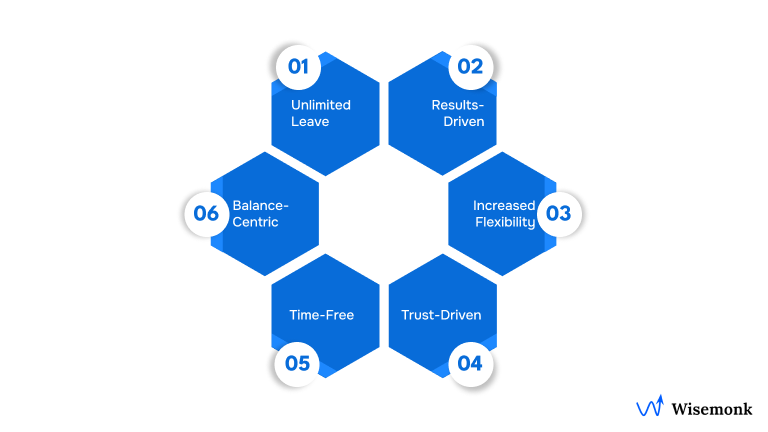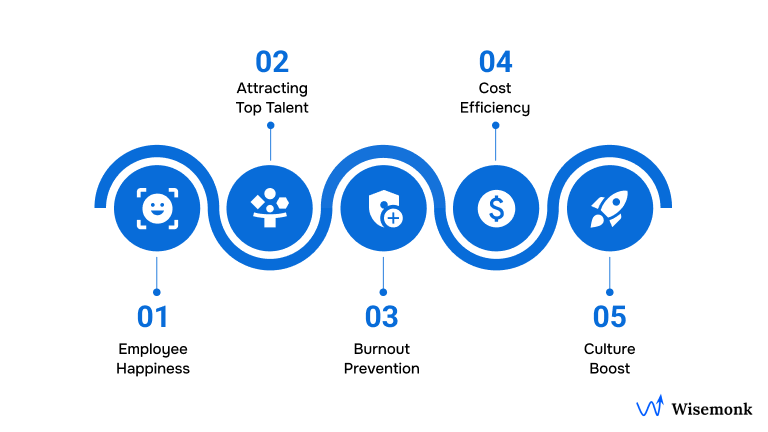- Unlimited PTO allows employees to take as much time off as needed without a set number of days.
- It focuses on trust, productivity, and work-life balance.
- 72% of employees are interested in unlimited PTO, reflecting a high demand for flexibility.
- Benefits include improved satisfaction, attracting talent, and reducing burnout.
- Challenges include potential abuse, unclear boundaries, and difficulty tracking time off.
- Success depends on clear guidelines, communication, and mutual trust.
In recent years, the concept of work-life balance has evolved significantly, with younger generations increasingly prioritizing flexibility in their careers. The idea of unlimited paid time off (PTO) has emerged as a promising solution to this shift, offering employees the freedom to take time off whenever needed without worrying about accumulating leave days.
Employee interest in unlimited PTO is high; a MetLife study found that 72% of workers expressed interest in working under an unlimited PTO policy, highlighting its appeal for work-life balance.
As more companies adopt this progressive approach, understanding the benefits and drawbacks of unlimited PTO has become essential for employers looking to implement it effectively.
In this blog, we will explore the key advantages and challenges of unlimited PTO, helping you navigate this modern workplace trend.
What is Unlimited PTO?
Unlimited PTO, or unlimited paid time off, is a flexible leave policy that allows employees to take as much time off as they need, without a set number of days allocated per year. Unlike traditional PTO systems, where employees are given a specific number of paid vacation or sick days, unlimited PTO grants employees the autonomy to manage their own schedules and take time off based on personal needs or preferences.
While the policy sounds generous, its successful implementation relies on trust between employers and employees, ensuring that work commitments are met while offering greater freedom and flexibility in managing time off.
Key Features of Unlimited PTO Are:

- No Set Limit on Time Off: Employees can take as much time off as needed, without a predefined number of vacation or sick days.
- Focus on Results, Not Hours: The policy emphasizes productivity and outcomes rather than tracking specific hours or days worked.
- Increased Flexibility: Employees have the freedom to schedule time off based on personal or family needs.
- Trust-Based Policy: Successful implementation depends on mutual trust between employers and employees to ensure work responsibilities are met.
- No Accumulation or Expiration: Unlike traditional PTO, there’s no need to accumulate time off or worry about unused days expiring at the end of the year.
- Work-Life Balance Focus: Aimed at helping employees manage their work and personal life more effectively.
In summary, unlimited PTO offers flexibility and autonomy, but its success hinges on clear expectations and trust between employers and employees.
Now, let's explore how unlimited PTO works in practice and how companies can implement it effectively.
How Unlimited PTO Works
Not all unlimited PTO policies are the same, but they generally follow a similar process. While the policy gives employees flexibility, it still operates within a structured system that requires time-off requests to be submitted through the appropriate channels.
Here’s a typical process for how unlimited PTO works:- Request Time Off: Employees must request time off through their manager, even though there’s no set limit on days.
- Manager Approval: After submission, the manager reviews and approves the request, ensuring that the employee’s workload and team needs are considered.
- Trust-Based System: The policy is based on trust that employees won’t abuse the system. Frequent or excessive requests may raise questions about the balance between time off and job responsibilities.
- Unwritten Guidelines: Many organizations have informal rules or guidelines in place to ensure that employees take time off without affecting their contributions or work quality.
- Empowerment for Employees: Employees are empowered to make decisions about how to allocate their time, fostering a sense of responsibility and autonomy in managing their work-life balance.
In essence, unlimited PTO operates within a flexible yet structured framework that encourages trust and autonomy, while maintaining productivity and accountability.
Now, let's explore the key benefits that unlimited PTO offers to both employers and employees.
Benefits of Unlimited PTO

For employers, unlimited PTO offers several strategic advantages that can help improve overall workplace culture, employee satisfaction, and retention. While it may seem like a bold move, many companies have found that the benefits far outweigh the challenges when implemented thoughtfully.
Below are some of the key benefits of offering unlimited PTO from an employer’s perspective:
1. Improved Employee Satisfaction
Unlimited PTO provides employees with the flexibility to take time off as needed, which can significantly boost morale and job satisfaction. When employees feel trusted to manage their time, they are often more engaged and motivated to deliver high-quality work, knowing their well-being is prioritized.
2. Attracting Top Talent
Offering unlimited PTO can make your company more attractive to top candidates, particularly those who prioritize work-life balance. As millennials and Gen Z workers place higher value on flexibility, having such a policy can set your organization apart from competitors, helping you attract and retain high-caliber talent.
3. Reduced Employee Burnout
Providing unlimited PTO encourages employees to take the necessary time off to recharge, which can help reduce burnout and improve long-term productivity. Employees who take regular breaks are less likely to experience exhaustion and more likely to stay focused and productive during their working hours.
4. Lower Administrative Costs
Traditional PTO systems require tracking and managing accrued time off, which can be time-consuming and costly for HR departments. With unlimited PTO, the administrative burden is reduced, as there’s no need to track accrued days or ensure employees are using their time appropriately.
5. Enhanced Company Culture
A flexible time-off policy fosters a culture of trust and mutual respect between employees and management. When employees feel they can take time off without guilt, it creates a positive work environment and helps develop a culture where employees feel empowered to manage their professional and personal lives effectively.
While unlimited PTO offers numerous benefits, it's also important to consider the potential challenges that come with it.
Drawbacks of Unlimited PTO
While unlimited PTO can be an attractive policy, it’s not without its drawbacks. Some employers may find it difficult to implement successfully, and employees might face challenges in managing the policy effectively.
Below are a few common drawbacks that organizations should consider before adopting unlimited PTO:
1. Potential for Abuse
One of the main concerns with unlimited PTO is the potential for abuse. Without clear guidelines, some employees may take excessive time off, leading to reduced productivity and possible resentment among coworkers who feel burdened by additional responsibilities. Without a solid structure, it can be difficult to manage the balance between flexibility and performance.
2. Lack of Clear Boundaries
Unlimited PTO can create confusion around expectations for time off. Employees may feel uncertain about how much time they should take, leading to hesitation or guilt when requesting leave. This can result in employees not using the policy as intended, which defeats the purpose of providing flexibility.
3. Uneven Usage Across Teams
In some cases, certain teams or departments may struggle more than others to manage time off due to high workloads or critical project deadlines. This can lead to unequal distribution of time off, where some employees take advantage of the policy while others feel pressured to continue working without taking breaks.
4. Difficulty in Tracking Time Off
Although unlimited PTO reduces the need to track days, it can still create challenges for employers in terms of overall workforce management. Without a formal tracking system, HR teams may find it difficult to evaluate absenteeism or assess trends in time-off requests, which can complicate workforce planning.
5. Risk of Reduced Vacation Time
Some employees may end up taking less time off than they would under a traditional PTO policy, fearing judgment for taking too much time off. This can lead to employees burning out, as they feel pressure to always be available and never take extended breaks.
Unlimited PTO, while beneficial in many ways, comes with challenges that require careful consideration and management to ensure it supports both employees and the organization effectively. Let's look at some common types of PTO.
Common Types of PTO
Paid Time Off (PTO) policies can vary widely across companies, giving employees different options for time off depending on their needs. Understanding the various types of PTO helps businesses tailor their policies to best suit both employee preferences and organizational goals.
Effective PTO management is crucial for maintaining a balanced work environment and ensuring that both employees and employers benefit from flexible time-off policies.
To address the challenges of managing unlimited PTO, Wisemonk provides a comprehensive solution for streamlining HR processes and leave policies.
Effortless HR Management: How Wisemonk Optimizes Leave Policies
Managing leave policies can be a complex and time-consuming task for businesses, often leading to compliance issues and employee dissatisfaction. Wisemonk addresses these challenges by offering a comprehensive leave management solution.
Wisemonk streamlines leave management through:
- Customizable Leave Policies: Design and implement leave policies that align with company culture and comply with labor laws.
- Automated Leave Tracking: Monitor and manage employee leave balances and accruals in real-time.
- Employee Self-Service Portal: Allow employees to request and track their leave through an intuitive interface.
- Compliance Assurance: Ensure adherence to statutory requirements like PF, ESIC, and PT.
Check our pricing today and see how Wisemonk can transform your HR management. Contact us to learn more about our tailored solutions!





%20(5).webp)

